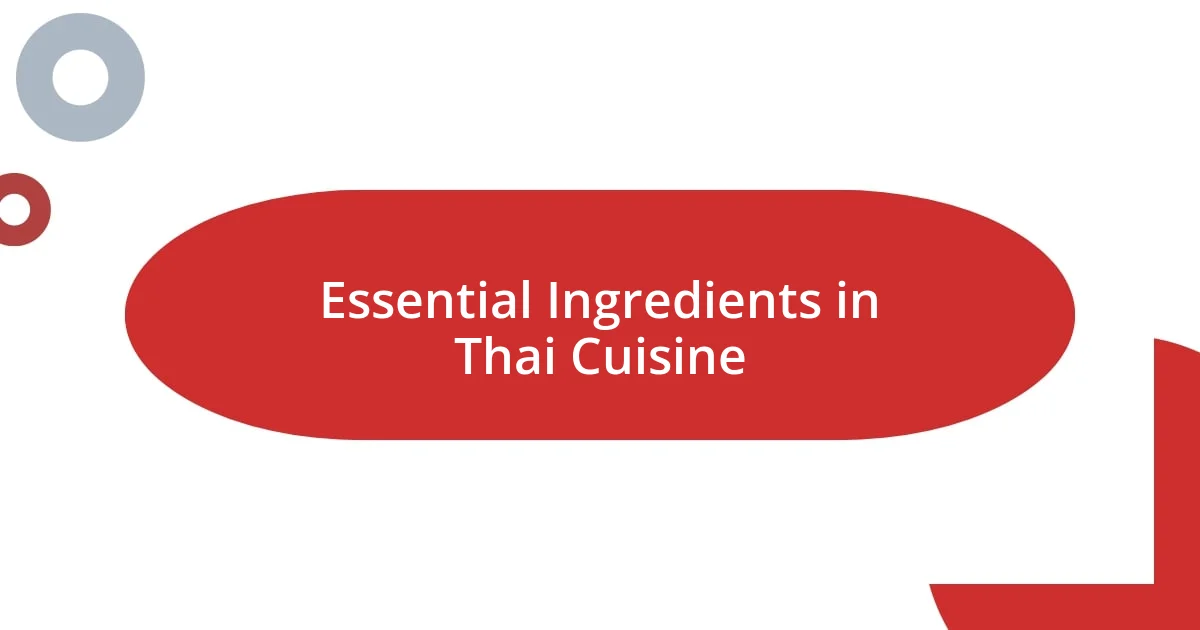Key takeaways:
- Thai cooking emphasizes a balance of sweet, sour, salty, and spicy flavors, often achieved through the use of fresh ingredients and aromatic herbs.
- Essential ingredients like fish sauce, lemongrass, and Thai basil play a crucial role in defining the unique flavors of Thai cuisine.
- Popular cooking techniques such as stir-frying, simmering, and steaming ensure vibrant tastes and textures while enhancing the depth of flavors in dishes like curry and dumplings.

Understanding Thai Cooking Basis
Understanding the essence of Thai cooking truly begins with its balance of flavors. I remember my first attempt at making a classic Pad Thai; the struggle to get that perfect harmony of sweet, sour, salty, and spicy felt like an art form I was just learning to master. Have you ever tasted a dish that made you pause and savor every nuance? That’s what Thai cuisine embodies.
The foundation of Thai dishes often resides in fresh ingredients and aromatic herbs. I’ve never forgotten the scent of lemongrass wafting through the air as I chopped it for a green curry. The energy in the kitchen, surrounded by vibrant colors and fragrant herbs, makes cooking feel almost ceremonial. Isn’t it amazing how such simple elements can transform a dish into something extraordinary?
Moreover, the use of techniques such as stir-frying and simmering reflects the interplay of quick preparation with deep flavors. During a cooking class in Thailand, I learned that timing is crucial; those fleeting moments in the wok can elevate a meal from average to exceptional. So, how do you ensure that your flavors develop without losing that fresh essence? It’s all about knowing when to add each ingredient to the pan, an intuitive dance that makes every cooking experience in Thai cuisine unique.

Essential Ingredients in Thai Cuisine
When I think about the essential ingredients in Thai cuisine, the first thing that comes to mind is the vivid colors and unique aromas. Imagine biting into a fresh chili pepper or tearing a leaf of Thai basil — it feels like the spirit of Thailand comes alive on your plate. Fresh ingredients are more than just components; they are the heartbeat of each dish, driving the flavors we crave.
One can’t overlook the importance of fish sauce, a staple that I learned to appreciate during my travels. It’s salty, savory, and complex, adding depth to dishes like spicy papaya salad (Som Tum). The first time I used it in a recipe, I was mesmerized by how this single ingredient seemed to enhance the entire meal. Have you ever had an experience where a simple addition transformed the flavor completely? That’s the magic of Thai cooking!
To truly understand Thai cuisine, we must also consider the role of spices and herbs. Fresh coriander and kaffir lime leaves evoke memories of bustling street food markets, and their bright, zesty flavors take me back to joyful gatherings around a dinner table. The way these elements work together is like a symphony; each note plays a critical part in that delightful, mouthwatering experience.
| Ingredient | Description |
|---|---|
| Lemongrass | A fragrant herb that adds a citrusy flavor, often used in soups and curries. |
| Fish Sauce | An essential salty seasoning that enhances umami flavor in dishes. |
| Thai Basil | Aromatic basil variety with a hint of spice, perfect for stir-fries. |
| Kaffir Lime Leaves | Leaves that impart a unique citrus aroma, often used in curries and salads. |
| Chili Peppers | Provides heat and vibrancy, a key element in Thai cooking. |

Popular Thai Cooking Techniques
When diving into the popular cooking techniques of Thai cuisine, the first method that comes to my mind is stir-frying. It’s a technique that I’ve often relied on for weeknight dinners, and I love how it captures the vibrant flavors while keeping the ingredients crunchy and fresh. I remember the first time I tossed my veggies in a smoking hot wok; the sizzle was exhilarating, creating a beautiful dance of colors that made my heart race with excitement.
Another beloved technique, simmering, is essential for savoring the depth of flavors in curries and soups. I still recall the comforting smell wafting from my pot as I let my curry meld its spices slowly. It’s a gentle reminder that patience pays off, as the low heat truly brings out the richness of each component.
Here’s a quick summary of popular Thai cooking techniques:
- Stir-Frying: Quick cooking method that maintains the crunch and color of vegetables.
- Simmering: Slow cooking that allows flavors to deeply infuse, perfect for curries and soups.
- Steaming: Preserves nutrients and texture; ideal for dumplings and fish dishes.
- Grilling: Adds a smoky flavor, commonly used for satays and marinated meats.
- Pounding: Essential for making pastes from fresh herbs and spices, enhancing flavor profiles in dishes like curry.
Each technique offers its own magic, and diving into them has transformed my approach to cooking!

Exploring Thai Curry Preparation
When it comes to preparing Thai curry, the foundation lies in the curry paste. I vividly remember the first time I pounded fresh ingredients together—galangal, lemongrass, and dried chili—into a fragrant paste. There’s something mesmerizing about the rhythmic motion of the mortar and pestle, and that intoxicating aroma fills the kitchen, making my heart skip a beat. Have you experienced the joy of transforming raw ingredients into a homemade paste? It’s truly rewarding and elevates the final dish tremendously.
Next, let’s talk about simmering the curry. Once I’ve added my paste to hot oil, the sizzle ignites a wave of anticipation. The vibrant colors and rich fragrance seem to weave a dream of warmth and comfort. I recall a chilly evening when I was feeling down, and a creamy yellow curry infused with coconut milk instantly lifted my spirits. As it simmered, the flavors melded beautifully, and the entire house was filled with a sense of home. There’s nothing quite like how a good curry can wrap you in a hug after a long day!
To finish it off, I always opt for fresh herbs and a squeeze of lime juice. The moment I sprinkle cilantro and drop in a wedge of lime, the dish comes to life. Each bite bursts with bright and zesty flavors, and I can’t help but smile, knowing I’ve captured the essence of Thai culinary magic. Isn’t it incredible how a few simple touches at the end can elevate a dish from good to unforgettable?

Perfecting the Art of Steaming
Steaming is one of those techniques that I find both simple and profoundly effective. The first time I used a bamboo steamer, I was captivated by how it preserved the vibrant colors and delicate flavors of the food. Watching shrimp dumplings gently steam to perfection, I felt like I was in a cooking class, eager to master this method. Doesn’t it feel satisfying to cook food that not only tastes amazing but also looks beautiful?
What I’ve discovered over the years is how steaming truly locks in moisture and nutrients. On one occasion, I prepared a whole fish, marinated in ginger and soy sauce, and placed it in the steamer. The result was nothing short of enchanting—the fish was tender, flaky, and bursting with flavor, while the kitchen filled with a heavenly aroma. Have you ever cooked something that made the whole room stop and notice? That’s the magic of steaming.
Another aspect I enjoy is the versatility steaming offers, from vegetables to desserts. Recently, I experimented with a dessert called “khao tom mud,” where I wrapped glutinous rice in banana leaves and steamed it. The anticipation as I unwrapped the leaves was almost too much to bear! It reminded me how, in cooking, patience is often the key to unveiling delicious surprises. Have you explored the myriad possibilities that steaming can bring to your kitchen? I highly recommend giving it a try!

Tips for Authentic Thai Flavors
One of the simplest ways to achieve authentic Thai flavors is to embrace fresh, high-quality ingredients. I learned this lesson the hard way during a visit to a bustling market in Bangkok; the vibrant produce and aromatic herbs just sang to me. When I came home, I realized that nothing beats using fresh basil, lime leaves, and galangal over dried versions. Isn’t it fascinating how those fresh ingredients can transform ordinary dishes into something truly spectacular?
Another tip I swear by is to balance the flavors meticulously. Thai cuisine is all about harmony, and during my first attempt at pad Thai, I was overwhelmed trying to hit that perfect balance of sweet, sour, salty, and spicy. I remember adding just a dash of tamarind paste and a sprinkle of sugar a little at a time until I felt that magical connection. Have you ever had that moment in cooking when everything finally comes together? It’s like a symphony playing in your mouth!
Don’t underestimate the power of homemade sauces and condiments in elevating your dishes. I can’t stress enough how much better homemade chili paste tastes compared to store-bought. The first time I made a batch, using roasted garlic, dried chilis, and shrimp paste, I was astonished by the depth of flavor! Have you tried making your own sauces? It’s a rewarding process that breeds confidence in your cooking and brings a level of authenticity to your meals that packaged versions just can’t match.















